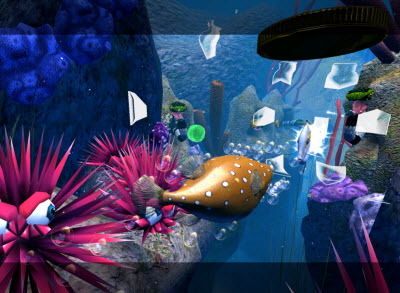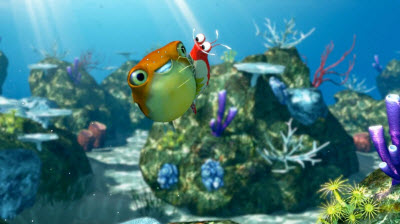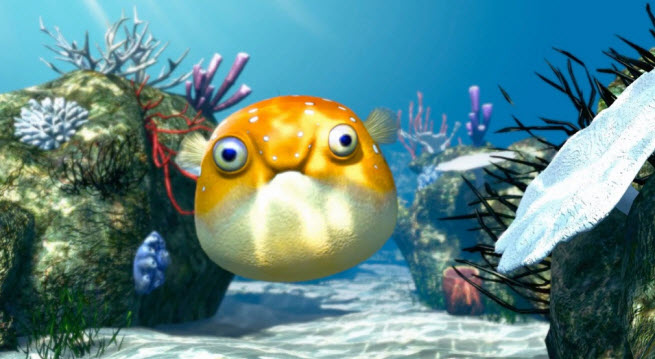WemoLab snared admirers with the launch of its graphically beautiful 3D animated undersea world, The Blu. Now it is going after iPad fans with the launch of SuperFugu, an interactive tablet app built around a cartoonish pufferfish. SuperFugu offers kids a “digital field trip” of the world’s oceans and allows them to interact with and learn about aquatic species.
 The app indicates that some developers are investing heavily in 3D graphics to stand out from a sea of competitors on mobile platforms, and that will drive mobile platforms to adopt better technology. If it takes off, it will show there is growing appetite for family content on mobile platforms.
The app indicates that some developers are investing heavily in 3D graphics to stand out from a sea of competitors on mobile platforms, and that will drive mobile platforms to adopt better technology. If it takes off, it will show there is growing appetite for family content on mobile platforms.
SuperFugu is an educational app, and those haven’t always been the most enthralling for kids. But Venice, Calif.-based WemoLab is shooting to wow iPad users with beautiful graphics. The company has built the game on its high-end technology platform that it used to create The Blu, which the company quietly released on PC a year ago.
“We set this up to create the next-generation app,” said co-founder and chief executive officer Neville Spiteri. “It is an immersive and meaningful experience. We call it a digital field trip.”
The new app lets you play as a superhero pufferfish who has to free fish that have been captured by an evil octopus. Along the way, you collect golden coins (an homage to Super Mario Bros.) and watch out for predators. Fortunately, most other sea creatures don’t want to eat the poisonous SuperFugu. The app is aimed at luring kids into WemoLabs’ high-end product, The Blu, which is unique as a creative platform.
With The Blu, WemoLab created an underwater world imbued with artificial intelligence and a scientifically accurate environment. Without advertising, that world has grown to 100,000 users in 100 countries.
WemoLab created fish that behaved with the appropriate A.I., and it also created a platform so that third-party artists could create their own 3D-animated fish. The company curated the art submitted by the community of artists, and it wound up with submissions from more than 300 artists, known as Makers. They design their fish and get credit for their submissions, which can roam free in the ocean. Users can start their own sub-worlds, or habitats, and purchase the fish with virtual currency. Tapping the A.I. technology, the fish function as expected once the artist lets them loose in the world.
The platform is both educational and aimed at saving the world’s oceans, so it has garnered support from a variety of ocean experts, including Time Magazine’s Hero for the Planet, Sylvia Earle, a National Geographic explorer-in-residence. She narrates some of the experience, explaining the plants and creatures that you interact with in the ocean. You can visit different habitats in the world to check out fish in different environments. You can build your own habitat and populate it with fish — many created by Makers — that you can buy. About 25 percent of the proceeds go to Makers in The Blu, and 25 percent goes to nonprofits.
Spiteri said the world is monetizing in a healthy way. You can also adopt a fish and see where it swims in the ocean. When you click on them, you can see where they are from and who their owners are. In that respect, the game has a social component.
 “Wemo stands for ‘world emotion,’ and our goal is to create next-generation, immersive connected experiences that bring people together from all over the world,” said Spiteri. “The feedback we received on The Blu overwhelmingly demonstrated that there is an exploding appetite for family-centric content with an element of learning and fun.”
“Wemo stands for ‘world emotion,’ and our goal is to create next-generation, immersive connected experiences that bring people together from all over the world,” said Spiteri. “The feedback we received on The Blu overwhelmingly demonstrated that there is an exploding appetite for family-centric content with an element of learning and fun.”
With The Blu, WemoLab taped Academy Award-winning animation director Andy Jones, who created art for James Cameron’s Avatar film. Among the creatures Jones designed was a giant blue whale that swims throughout the ocean. The whale was auctioned off at a Wildaid event last year, and it garnered $10,000 for the charity. Wemo habitat creators and sponsors include The Smithsonian, Scripps Institution of Oceanography, The Ocean Elders, and others. Players can make donations from within the game that benefit ocean charities. Twelve habitats have been built, and four more are under construction in The Blu.
Jones also helped with the creation of SuperFugu, which is controlled through simple swipe maneuvers. Creators can build their own Fugu skins, and children can become “mini Makers” by submitting their own color drawings to be included in the game as a Fugu skin. Wemo added parental control features that enable parents to restrict purchases through tools such as a coin allowance. Parents can also set a timer for playtime and review a report card that promotes conversation. SuperFugu monetizes in a similar way to The Blu, where you can buy fish.
The free version of the game has 16 levels of play. WemoLab will add more levels over time and create new habitats from around the world, such as the Arctic or the Kelp Forests. The artwork is good on the iPad, but it isn’t nearly as breathtaking as the look of The Blu, which features 3D animated creatures and ocean waters in different shades of blue.
WemoLab was founded in 2010 by Spiteri, Scott Yara, and Anthony Batt. The firm now has 13 employees. They received $2 million in funding from angel investors including Digital Garage, headed by MIT Media Lab director Joi Ito. And in October, they raised another $2.5 million from strategic angels. Over time, Spiteri hopes there will be thousands of artists and children contributing to The Blu and SuperFugu.
Spiteri said that his team is at work on a second virtual-world platform dubbed The Green. That one is a world of plants, butterflies, birds, and other wildlife.
VentureBeat's mission is to be a digital town square for technical decision-makers to gain knowledge about transformative enterprise technology and transact. Learn More

